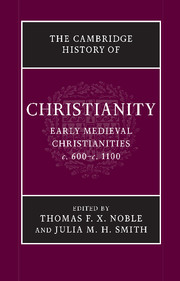Book contents
- Frontmatter
- Introduction: Christendom, c. 600
- Part I Foundations: Peoples, Places, and Traditions
- Part II Christianity in Confrontation
- 7 Christians and Jews
- 8 The Mediterranean Frontier: Christianity face to face with Islam, 600–1050
- 9 Christians under Muslim rule
- 10 Latin and Greek Christians
- 11 The northern frontier: Christianity face to face with paganism
- Part III Christianity in the Social and Political Order
- Part IV Christianity as Lived Experience
- Part V Christianity: Books and Ideas
- Conclusion: Christendom, c. 1100
- Bibliographies
- Index
- References
11 - The northern frontier: Christianity face to face with paganism
from Part II - Christianity in Confrontation
Published online by Cambridge University Press: 28 March 2010
- Frontmatter
- Introduction: Christendom, c. 600
- Part I Foundations: Peoples, Places, and Traditions
- Part II Christianity in Confrontation
- 7 Christians and Jews
- 8 The Mediterranean Frontier: Christianity face to face with Islam, 600–1050
- 9 Christians under Muslim rule
- 10 Latin and Greek Christians
- 11 The northern frontier: Christianity face to face with paganism
- Part III Christianity in the Social and Political Order
- Part IV Christianity as Lived Experience
- Part V Christianity: Books and Ideas
- Conclusion: Christendom, c. 1100
- Bibliographies
- Index
- References
Summary
Christianity, deviance, and paganism
Officially the Roman Empire had been Christianized by the end of the fourth century. Although the barbarians who crossed its frontiers in the fourth and fifth centuries were pagan, the majority of them soon accepted Christianity. By the sixth century the religion had even spread beyond the borders of what had been the empire. Christians were to be found in the Celtic west, notably Ireland, and also in the heartlands of Germany in the land of the Thuringians. On the other hand Christianity was by no means a monolithic religion, even in its old heartlands. The leaders of the church might have wanted it to be, but the bishops of Rome, Constantinople, and Alexandria, to name but three, frequently differed in their own definitions of their religion. Moreover different regions and groups adopted different doctrines and different patterns of organization, not least because of preexisting social patterns. This is most obvious in a region as distinctive as Ireland, but every part of Christendom had its own practices: its own liturgy as well as its own attachment to different saints and cults. The depth of Christianization was also a matter of concern. Many pre-Christian practices intended to ensure good harvests or safe childbirth, to predict the weather, or to ward off evil had not been abandoned, and indeed in some cases would not be abandoned until well into the modern period. Leading bishops, whose own religious commitment was radically more impressive than that of the majority of the population, understood their religion, and the demands it made, very differently from most of the laity.
- Type
- Chapter
- Information
- The Cambridge History of Christianity , pp. 230 - 246Publisher: Cambridge University PressPrint publication year: 2008



